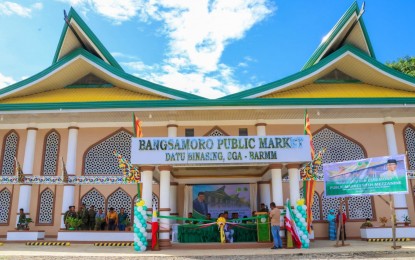From the Philippine News Agency (Jul 20, 2024): Things looking up for BARMM; poverty rate on the decline

LOOKING UP. A public market in remote Barangay Binasing in Pigcawayan, North Cotabato, which is now part of the Special Geographic Area-Bangsamoro Autonomous Region in Muslim Mindanao, after its turnover on Nov. 27, 2023. The Marcos administration hopes to reduce the poverty incidence in the region to a single digit by 2028, from the 34.8 percent during the first half of 2023. (Photo courtesy of MILG-BARMM)
MANILA – The poverty incidence in the Bangsamoro Autonomous Region in Muslim Mindanao (BARMM) continues to decline under the administration of President Ferdinand R. Marcos Jr.
BARMM Cabinet Secretary Asnin Pendatu said at the Saturday News Forum in Quezon City
that from 39.4 percent in 2021, the data dropped to 34 percent.
“So, patuloy ho iyong pagbaba (it continues to go down) during this administration of President Ferdinand “Bongbong” Marcos,” Pendatu said. “The autonomy that was granted to the BARMM was the right track to take kasi (because) it produces results.”
President Marcos is targeting to reduce poverty incidence in BARMM to a single digit by 2028.
Pendatu said BARMM is hopeful as well.
“Mayroon naman pong mga (There are) signs or at least we have forthcoming investments that we see that would help in further reducing the poverty incidence in the region,” he said.
Owing to the region’s “relatively better peace and security situation,” he said that PHP3.1 billion worth of investments translated to 1,927 job opportunities in 2023.
Pendatu said they are also exploring the possibility of developing natural gas and other natural resources in BARMM, particularly in the Liguasan Marsh.
President Marcos fully supports BARMM development, according to Office of the Presidential Adviser on Peace, Reconciliation and Unity Secretary Carlito Galvez Jr. during the same forum.
“For example, sa (in) food security, BARMM can answer the cattle industry. Second, in terms of agriculture, aquaculture at saka sa (and) fisheries,” he said.
Referring to Pendatun’s report, Galvez said more or less 30 percent of the country’s fisheries and other food products are from BARMM.
At the Global Peace Summit which Galvez attended in Oslo, Norway last month, he said the Bangsamoro Peace Agreement received positive feedbacks.
“Nakikita natin na isa ito sa mga nagiging ehemplo ng ibang bansa (It has become a model for other nations) in terms of the implementation at saka (and) in terms of the conception of the agreement,” Galvez said.
Galvez said the “BARMM peace process has a bright future” and the region will reach another major milestone when it holds the first BARMM parliamentary election on May 12, 2025.
The Framework Agreement on the Bangsamoro started the dream for autonomy under the late President Benigno Aquino III in 2012.
However, the 16th Congress, with President Marcos still a senator then, failed to pass the Bangsamoro Basic Law (BBL) when it adjourned in 2016.
President Rodrigo R. Duterte made good on his promise to bring peace to the region, pushing for the BBL and eventually a more inclusive Republic Act 11054, also known as Organic Law for the BARMM. It was signed into law in July 2018, replacing the Autonomous Region in Muslim Mindanao.
The law was ratified by twin plebiscites in Feruary 2019, immediately followed by the creation of the Bangsamoro Transition Authority.
https://www.pna.gov.ph/articles/1229413

No comments:
Post a Comment
Note: Only a member of this blog may post a comment.